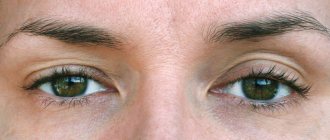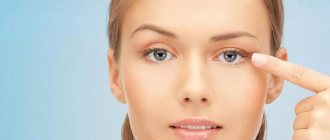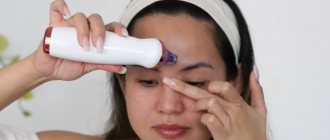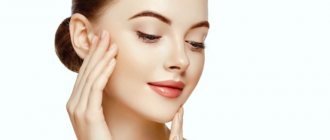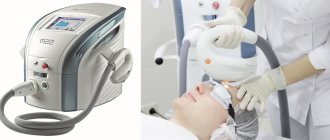Symptoms of facial ptosis
The process of biological aging of the body is manifested in a decrease in the firmness and elasticity of the skin. Collagen fibers degrade, water balance is lost, and cell regeneration slows down. These processes cause the appearance of wrinkles, nasolabial folds, and shifting of soft tissues.
Gravitational ptosis of the face, which deforms its oval, occurs against the background of ongoing changes. Thin tissues are unable to withstand the natural forces of gravity.
Ptosis of facial tissues is a condition when, under the influence of gravity, they noticeably droop. Jowls appear at the bottom, and the corners of the eyes and mouth point downwards.
Initial signs of changes appear after 35-40 years, their intensity depends on the individual characteristics of the organism. Sections of the face sag at different rates: the upper section (in the eye area) is the first to suffer, then the lower and middle.
The dynamics of development of appearance defects is divided into three stages:
First degree:
- Folds appear on the upper eyelid, noticeable only when the eyes are open
- The curve of the eyebrows is smoothed out, they acquire a horizontal position.
- Nasolabial folds deepen.
- There is blurring in the lower part of the jaw contour.
Second degree:
- Thickening and sagging of the skin over the bridge of the nose.
- The appearance of crow's feet, wrinkles on the forehead and between the eyebrows.
- The fold of the upper eyelid takes on a pronounced shape and does not disappear when the eyes are closed.
- Sagging of soft tissues in the eye area, which leads to rounding of the lower eyelid.
- Ptosis of the corners of the mouth, giving a dull appearance.
- The fatty tissue from the cheekbones goes down, creating an overhang over the nasolabial fold.
Third degree:
- The sagging process extends to the neck.
- Noticeable longitudinal folds form in the chin area.
- All symptoms of grade II gravitational ptosis intensify, wrinkles and furrows become deeper.
- The contour of the lips is smoothed, the entire skin becomes thinner.
Typing of blepharoptosis and causes
Blepharoptosis is divided depending on the time of occurrence, damage to one or two eyes at once and the degree of drooping of the eyelid, respectively, into:
- one- and two-sided;
- congenital and acquired;
- partial, incomplete and complete (degrees).
Congenital ptosis
A child may most likely inherit the pathology due to the presence of it in at least one of the parents or receive it as a result of injury during pregnancy or childbirth.
Main reasons:
- Genetic absenteeism (deficiency) of the upper eyelid muscle is often accompanied by other anomalies of the visual apparatus (strabismus, amblyopia, anisometropia, and so on).
- Damage or underdevelopment of the cranial (oculomotor) muscles, which are responsible for the movement of the eyelid.
- Neurogenic ptosis is a disorder of the oculomotor nerve due to its abnormal intrauterine development, usually bilateral. Appears when a child is diagnosed with Horner's syndrome, in combination with miosis and enophthalmos.
- Marcus syndrome is rare and usually unilateral. With this anomaly, the muscle of the upper eyelid is pathologically dependent on the masticatory and pterygoid muscles. That is, when yawning, chewing or opening the mouth, the triune nerve gives an impulse to the muscle responsible for the movement of the eyelid, as a result of which the eyelid lowers or rises. This pathology develops due to lesions of the brain stem, often accompanied by strabismus and amblyopia.
- Changes in the palpebral fissure vertically and horizontally - blepharophimosis, a rare pathology. The predisposition is genetic, more often in males or due to pregnancy pathologies during the formation of the upper and lower eyelids of the fetus.
Acquired ptosis
Acquired ptosis is more common than congenital ptosis and is usually unilateral. It appears due to injury, as a result of old age, and other diseases (various types of tumors, stroke and others). It is also distributed due to the appearance of:
- Neurogenic - a disturbance in the functioning of the oculomotor nerve (as a rule). The acquired form has a one-sided appearance. Appears due to various inflammatory processes or diseases, such as tumors, sclerosis, brain damage, diabetic neuropathy, injury to the nerve responsible for the movement of the visual apparatus, Horner's syndrome.
- Myogenic - neuromuscular pathology of the levator. It has a double-sided version. Appears due to dystrophy (myotonic), fatigue (myasthenia gravis) and muscle damage (myopathy).
- Aponeurotic - appears as a result of dystrophy, stretching of the tendon muscle responsible for raising the upper eyelid and its detachment from the tendon plate (aponeurosis) to which it is attached. Appears in old age or due to injury.
- Mechanical - is a consequence of deformation and impaired mobility of the upper eyelid. It develops when, with age, the elasticity of the skin is lost and excess skin forms in the eyelid area (dermatochalasis), due to tumors, injuries, swelling, scars.
Degrees
To determine the degree of ptosis, measure the distance between the middle of the pupil and the edge of the upper eyelid in millimeters. There are three degrees:
- first or partial - the eyelid covers one third of the pupil;
- second or incomplete - the eyelid covers 50% of the pupil;
- third or complete - the eyelid covers the entire pupil.
Early facial ptosis: causes of skin deformation
A phenomenon such as ptosis begins to affect the tissues of the human body immediately after birth. Gravity inexorably pulls the skin down, but the high elasticity of the young epidermis prevents it from sagging.
If the skin is weakened by improper care, lack of fluid and vitamins, poor environment or other factors, facial ptosis may appear at an early age.
The skin under the eyes is the first to lose elasticity, becoming covered with a network of fine wrinkles. Pronounced nasolabial folds appear next.
Why do aging processes actively start in young women? The causes of sagging tissue are related to processes occurring in the body. This is a complex problem that involves the facial muscles, fat layer and lymphatic system. Cosmetologists divide deformities into two types:
- Topical. There is a decrease in the tone of facial muscles due to stretching of some areas and shortening of others. Loss of skin elasticity and weakening of the muscle frame are two sides of the same process, because muscle fibers are closely intertwined with the dermis. Weakness of muscle tissue invariably affects the condition of the skin.
- Volumetric. Age-related biological processes affect all parts of the body, including the face. Tissue regeneration worsens, blood circulation and lymph outflow are disrupted. All these reasons cause swelling, making the skin more voluminous. The accumulation of fatty tissue in the cheek area is one of the reasons for their sagging. Manifestations of ptosis are more noticeable in women who are prone to obesity.
Early deformation begins around the age of 30, while the usual age for pronounced sagging of the lower part of the face is 40-45 years. Such manifestations are often hereditary. Their opposite is a genetic predisposition to late aging, when gravitational ptosis appears only at 50 years of age.
How to remove jowls and solve other age-related facial problems
Fortunately, it is possible to stop the aging process and get rid of jowls, as well as prevent their appearance. Facial gymnastics will help with this. “Just as training your butt prevents it from becoming flabby, face fitness prevents your face from losing tone,” explains Anastasia Burdyug.
The essence of gymnastics is that during its execution, the superficial muscles that are tightly woven into the skin of the face are worked out. This leads to a natural improvement in skin turgor and a reduction in swelling.
“Facial gymnastics allows you to literally turn back time,” adds Anastasia. “If you exercise regularly, there will be much fewer problems.”
Salon methods for solving the problem
Sagging skin and wrinkles do not pose any threat to health, but their harm to a woman’s psychological state is enormous. Modern cosmetology offers its arsenal of effective and not so effective methods that help fight tissue deformation and wrinkles. Treatment involves the following procedures:
- Hardware: laser resurfacing, skin tightening, microcurrent therapy, peeling.
- Injection: mesotherapy - treatment by introducing medications under the skin that stimulate its regeneration, injections of hyaluronic acid, Botox.
- Plastic surgery: face and neck lift, sewing in threads, blepharoplasty (eyelid correction).
- Various types of massage.
Treatment of I and II degrees of ptosis occurs with hardware and injection procedures, and the last stage of sagging of the lower part of the face, eyes and lips requires surgical intervention by plastic surgeons.
Methods to combat ptosis can be divided into several groups
1. Preventive. "Forewarned is forearmed!". If, looking at your relatives, you understand that there is reason to think about ptosis, start fighting it in advance. The more effective the result will be. Suitable for you:
- Gymnastics for the face - this technique will strengthen the muscles, keep them in good shape, and keep you in a good mood;
- Facial massages. Plastic and Spanish massages are especially relevant;
- Modeling masks.
2. Hardware techniques:
- RF lifting;
- SMAS-lifting;
- microcurrent therapy;
- fractional photothermolysis, etc.
3. Injection procedures:
- Botulinum therapy. If you have ptosis tendencies, then this type of correction should begin at a young age. If facial deformities from ptosis become quite obvious, botulinum toxin therapy can only be used after surgical correction;
- It is important to use fillers (based on hyaluronic acid and calcium hydroxyapatite) both to correct existing wrinkles and to correct lost facial volume. This method can easily eliminate nasolacrimal grooves, drooping corners of the eyebrows and corners of the lips, restore the volume of the cheekbones, and restore the beauty of the lips;
- Plasmolifting is a method of stimulating facial tone thanks to the body’s own forces. This method is now becoming increasingly popular due to its high efficiency and the ability to combine it with filler injections. This makes it possible to get a beautiful natural face.
- Mesothreads. Strengthens the skin and resists sagging.
4. Various types of peelings. 5. Surgical methods:
- Facelift (facelift);
- Blepharoplasty (upper and/or lower eyelid surgery);
- Platysmoplasty (neck lift).
Author of the article: Elena Stoyanova
Facial ptosis: how to deal with it at home
If treatment in beauty salons and clinics is not available to you, you can try to correct appearance defects at home. Correction of sagging areas is performed in several ways:
- Massage is an effective means of strengthening facial muscles. It can be performed not only in the salon, but also at home. There are several types of procedures, but the main one is modeling massage. It corrects the oval of the face, relieves puffiness, removes a double chin, and reduces wrinkles. The technique involves light stroking along the contour lines. The procedure is carried out 2 times a day, the course is 14 massages.
- Masks – tightening or lifting masks perfectly restore blurred facial contours. To prepare them at home, non-chemical substances and food products are used: cottage cheese, oatmeal, honey, chicken eggs and more. Lifting compositions smooth out fine wrinkles and increase the elasticity of the epidermis. For dry skin, a mask according to the following recipe is suitable: 100 g of oatmeal; 1 tbsp. spoon of sour cream; 1 tbsp. spoon of vegetable oil.
Pour boiling water over the oatmeal and leave to swell. After 10-15 minutes, add the remaining ingredients, mix and apply to the face.
For oily skin, another recipe is suitable:
- 1 protein;
- 1 teaspoon orange juice;
- melted honey
Mix the products thoroughly and apply to clean facial skin. Remove the mask with a damp cloth.
- Exercises. A set of exercises for the facial muscles helps combat the manifestations of ptosis. With its help you can get rid of double chin and jowls. Exercises can be performed at any time, in front of a mirror or at a table. Gymnastics for muscles helps tighten the skin.
Treatment methods for gravitational ptosis in aesthetic medicine
Modern cosmetology has many ways to combat age-related changes of varying intensity. Those who are no longer satisfied with their own appearance due to noticeable signs of natural biological aging can seek qualified help from cosmetology centers and aesthetic medicine clinics. Based on examination and diagnostic data, as well as taking into account the patient’s wishes regarding treatment results, the specialist will recommend several available treatment methods. Today, correction of gravitational ptosis of the face is carried out by surgical and hardware, non-surgical methods:
- contour plastic;
- bioreinforcement;
- thermolifting;
- photothermolysis;
- administration of injections containing hyaluronic acid and other anti-aging mixtures.
Most of these techniques are aimed at creating a lifting effect. The wide possibilities of modern cosmetology make it possible to restore their former youth even to patients for whom surgical operations are contraindicated. Hardware anti-aging procedures will help erase several years from your face, removing wrinkles, age spots and other defects. When choosing a method for correcting gravitational ptosis, the degree of tissue damage and the general medical history of a particular patient must be taken into account. If necessary, anti-aging procedures can be repeated if there are no contraindications. The cost of treatment directly depends on the chosen method.
